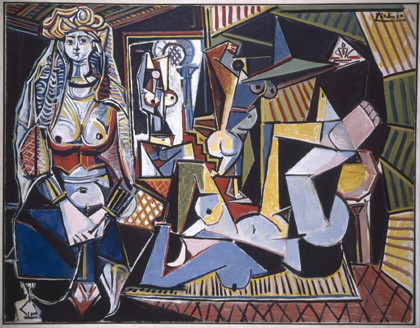Pablo Picasso, seventy-three years young, has taken up with a new woman. He chooses to announce the fact, in characteristically idiosyncratic style, by painting a series of pictures inspired by Eugene Delacroix’s The Women of Algiers of 1834. Delacroix’s Romantic masterpiece is a sombre and melancholic work, implacably opposed to the spirit of orientalist sexual fantasy that cheapens most nineteenth-century paintings of the Exotic East. In a dark and richly decorated sultan’s harem, three women wait in a condition of saddened boredom. What does Picasso make of this dispiriting sexual purgatory, more than a hundred years later? He turns its claustrophobic space into a buzzing confusion of Cubist planes and patterns. The women waiting have been stripped naked. One of them kicks her legs up in the air, while another bares her ingeniously rearranged breasts in a provocative manner. In Delacroix’s picture the sultan is nowhere to be seen, but in Picasso’s version he is present by implication, albeit invisible, as Picasso himself. This is his harem. To the left stands the towering figure of Jacqueline, the only woman to have been given a recognisable face. The picture was a kind of love letter, Picasso’s way of telling her that from now on she would be the one. It was also his final goodbye to Olga, to Marie-Therese, to Francoise and all the others.
“My work is like a diary,” Picasso once said. “It’s even dated like a diary”. He inscribed his final version of The Women of Algiers with the impressively precise date 14 February 1955. The picture hangs in the culminating room of the National Gallery’s new exhibition, “Picasso: Challenging the Past”, among a number of other themes and variations on the works of the Old Masters. Manet’s enigmatic Dejeuner sur l’Herbe, itself a provocative variation on...
“My work is like a diary,” Picasso once said. “It’s even dated like a diary”. He inscribed his final version of The Women of Algiers with the impressively precise date 14 February 1955. The picture hangs in the culminating room of the National Gallery’s new exhibition, “Picasso: Challenging the Past”, among a number of other themes and variations on the works of the Old Masters. Manet’s enigmatic Dejeuner sur l’Herbe, itself a provocative variation on...


